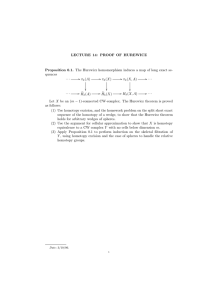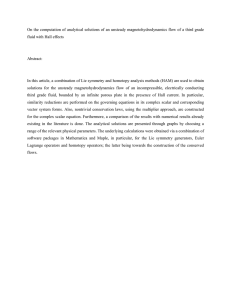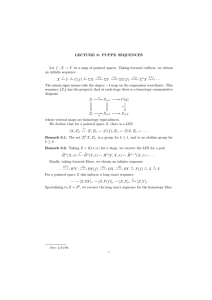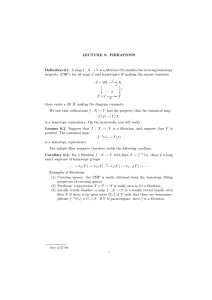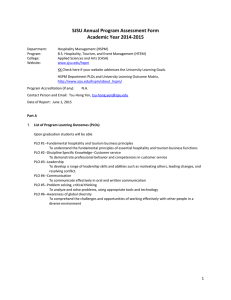TABLE OF CONTENTS CHAPTER TITLE
advertisement
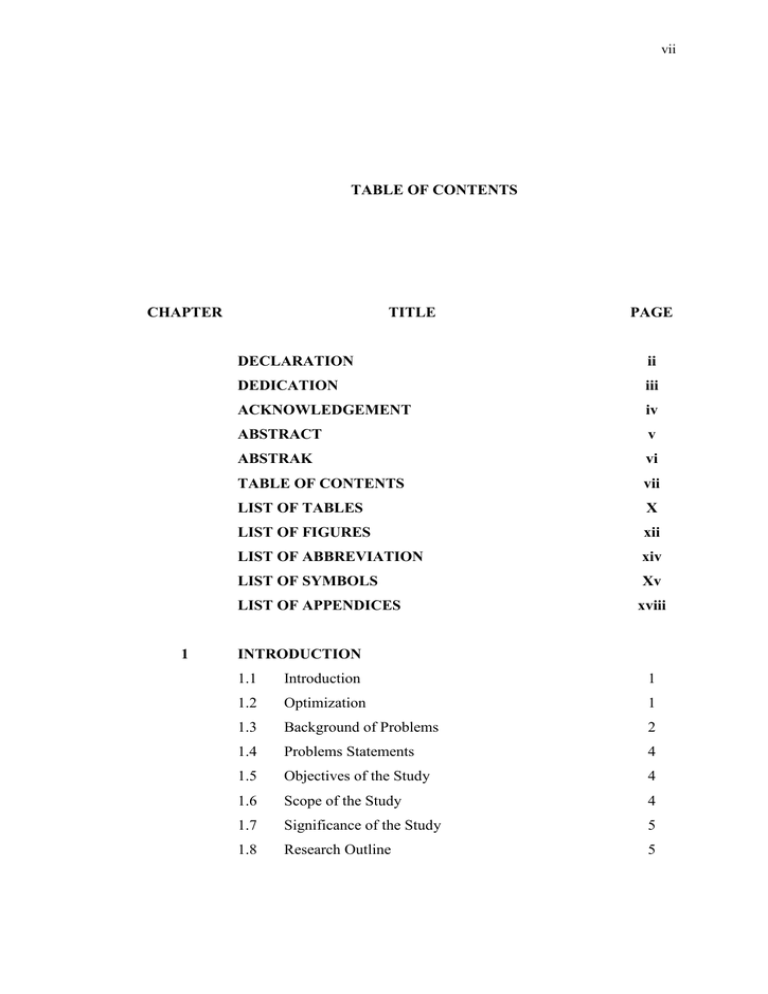
vii TABLE OF CONTENTS CHAPTER TITLE DECLARATION ii DEDICATION iii ACKNOWLEDGEMENT iv ABSTRACT v ABSTRAK vi TABLE OF CONTENTS vii LIST OF TABLES X LIST OF FIGURES xii LIST OF ABBREVIATION xiv LIST OF SYMBOLS Xv LIST OF APPENDICES 1 PAGE xviii INTRODUCTION 1.1 Introduction 1 1.2 Optimization 1 1.3 Background of Problems 2 1.4 Problems Statements 4 1.5 Objectives of the Study 4 1.6 Scope of the Study 4 1.7 Significance of the Study 5 1.8 Research Outline 5 viii 2 3 LITERATURE REVIEW 2.1 Introduction 7 2.2 Global Optimization Methods 8 2.3 Global Optimization 9 2.4 Homotopy 10 2.5 Intermediate Value Theorem 13 2.6 Predictor-Corrector Halley Method 14 2.7 Complexity Analysis 16 2.8 Mathematica 8.0 18 2.9 Summary 21 RESEARCH METHODOLOGY 3.1 Introduction 22 3.2 Research Design and Procedure 23 3.3 Homotopy 28 3.3.1 Homotopy Continuation Method (HCM) 28 3.3.2 Homotopy Optimization Method (HOM) 32 3.3.3 Homotopy Optimization with 33 Perturbations and Ensembles method (HOPE) 3.4 Intermediate Value Theorem (IVT) 34 3.5 Predictor-Corrector Halley's Method (PCH) 39 3.6 Homotopy 2-Step Predictor-corrector Method 40 (HSPM) 3.7 4 Complexity Analysis 44 3.7.1 Time Complexity Analysis (TCA) 44 3.7.2 Space Complexity Analysis (SCA) 45 RESULT AND DISCUSSION 4.1 Introduction 50 4.2 Test Problems 50 ix 4.2.1 Ability to Locate Local Minimizer 51 4.2.2 Ability to Locate More Than One Global 56 Solution 4.2.3 Ability of HSPM Over HOPE 59 Numerical Computation 63 4.3.1 Wilkinson Function 64 4.3.2 Dixon Function 67 4.3.3 Michalewicz Function 69 4.3.4 Dixon-Szego Function 72 4.3.5 Goldstein-Price Function 77 4.3.6 Summary 79 4.4 A Comparison of Success Rate 79 4.5 Complexity Analysis 88 4.5.1 Time Complexity Analysis (TCA) 89 4.5.2 Space Complexity Analysis (SCA) 95 4.5 Comparison between HOPE and HSPM 98 4.6 Conclusion 100 4.3 5 SUMMARY AND CONCLUSION 5.1 Summary of Study 101 5.2 Conclusion 103 5.3 Suggestions for Future Work 103 REFERENCES 105 Appendices A-D 108-123 x LIST OF TABLES TABLE NO. 2.1 TITLE PAGE Comparison advantages of Mathematica and other systems in automation. 2.2 Comparison advantages of Mathematica and other systems in integrated all-in-one platform. 2.3 19 19 Comparison advantages of Mathematica and other systems in hybrid symbolic-numeric 20 methodology. 2.4 Comparison advantages of Mathematica and other systems in multiparadigm language. 3.1 Limit on problem size as determined by growth rate. 20 47 3.2 Tenfold increase in speed. 48 4.1 Functions used for testing the strengths of HSPM. 51 4.2 Numerical result of Wilkinson function. 65 4.3 Numerical result of Dixon function. 69 4.4 Numerical result of Michalewicz function using Newton's method. 4.5 Numerical result of Michalewicz function using HSPM.. 4.6 Numerical result of Dixon-Szego function computed with good parameter s. 4.7 Numerical result of Dixon-Szego computed with poor parameter s. function 71 72 75 76 xi 4.8 Numerical result of Goldstein-Price function. 4.9 Computation of value m according to the parameter k and N. 4.10 Numerical result of 10-modal Sine function when m2. 4.11 Success rate of HOPE and HSPM when N=10. 4.12 Computing the worst case time complexity of HOPE. 4.13 Computing the worst case time complexity of HSPM. 4.14 Computing the best case time complexity of HOPE. 4.15 Computing the best case time complexity of HSPM. 4.16 Time complexity of HOPE and HSPM. 4.17 Computing function HOPE(x) and HSPM(x) when x=2, 20, 200. 4.18 Space complexity of HOPE in best and worst case. 4.19 Space complexity of HSPM in best and worst case. 4.20 Space complexity of HOPE and HSPM. 4.21 Time and space complexities of HOPE and HSPM (worst case). 4.22 Comparison of HOPE and HSPM 77 80 83 85 90 91 91 92 93 93 96 97 98 98 100 xii LIST OF FIGURES FIGURE NO. TITLE PAGE 3.1 Operational framework of the research. 25 3.2 Local minimum and global minimum. 26 3.3 Intermediate value theorem. 35 3.4 Flow chart of algorithm HSPM. 43 4.1 Wilkinson function. 52 4.2 Dixon function. 54 4.3 Michalewicz function. 55 4.4 Dixon-Szego function. 57 4.5 Goldstein-Price function. 59 4.6 N-modal Sine Function and its correspond 61 auxiliary functions with N 10, 20,30, 40,50,60 respectively. 4.7 Wilkinson Function varies from 0 to 1 . 64 4.8 Value of H '( x,0.6) based on s 0.01 and 67 s 0.001 . 4.9 Dixon Function varies from 0 to 1 . 68 4.10 Michalewicz Function varies from 0 to 70 1. 4.11 Dixon-Szego Function varies from 0 to 73 1. 4.12 Derivative values of Dixon-Szego function for s 0.2 and 0.3 re+spectively. 74 xiii 4.13 Goldstein-Price Function varies from 0 to 77 1. 4.14 10-modal Sine function varies from 0 to 81 1. 4.15 Result of success rate (%) of HOPE (Dunlavy, 85 2005) and HSPM for N=10. 4.16 Result of success rate (%) of HOPE (Dunlavy, 86 2005) and HSPM for N=20, 30, 40, 50, and 60 respectively. 4.17 Growth rates for n3 and n5 with input size 94 n 5. 4.18 Growth rates for n3 and n5 with input size n 100 . 94 xiv LIST OF ABBREVIATIONS DAEs - Differential Algebraic Equations GO - Global Optimization GOM - Global Optimization Methods HR - Hit and Run method HOPE - Homotopy Optimization with Perturbations and Ensembles HAM - Homotopy Analysis Method HCM - Homotopy Continuation Method HOM - Homotopy Optimization Method HPM - Homotopy Perturbation Method HSPM - Homotopy 2-Step Predictor-corrector Method IVT - Intermediate Value Theorem M8 - Mathematica version 8.0 min - Minimize/ minimum max - Maximize/ maximum ODEs - Ordinary Differential Equations PCH - Predictor-Corrector Halley's method sup - Supremum SCA - Space Complexity Analysis TCA - Time Complexity Analysis xv LIST OF SYMBOLS - A closed set which contained solution, big-Omega notation K - A corresponding value of c over function f, constant HOPE ( x) , - A function D - A nonempty, closed set c - A value/ element in between interval [a, b] g ( x) - Auxiliary function O - Big oh notation, constant - Big theta notation L,P - Constant k - Constant, number of iteration m - Controller of the sharpness of valley of Eq (4.7), HSPM ( x) parameter to adjust the step size st h - Convergence-control parameter ci , i 1, 2,... - Cost used for an algorithm ▄ - End of proof x* - Extremizers f ( x) - Function f or target function x (1) - Global solution H ( x, ) - Homotopy function - Homotopy parameter subintervali - i number of subintervals within interval [a, b] xvi - Infinitesimal change of the dependent variable, error, stopping criterion - Infinitesimal increment of the independent variable In - Interval x 0 , x0 - Initial guess xi ,0 - Initial point, randomly select from subintervali x (jk 1) - - Least upper bound for A a - Lower bound of an interval an - Lower bound of interval I n ai - Lower bound of subintervali cmax - Maximum number of points in an ensemble M - Maximum number of subintervali , constant mpt - Midpoint of interval d - Non-empty subset of n, j, i - Number of iteration c - Number of perturbations generated of each point in the j th point in the ensemble at the start of iteration k ensemble c ( k 1) - Number of points in the ensemble at the beginning of iteration k -ve - Negative value F ( x) - Objective function - Perturbation x (jk,0) - ( k 1) Point found by minimization starting at x j x (jk,i) - Point found by minimization starting at the ith ( k 1) perturbation of x j +ve - Positive value X, Y - Set O( g (n)), - Set of complexity function O(h(n)) , xvii A - Set contaning element lower bound of I n n - Size input, number of iteration, constant - Step length/ step size xk - Solution computed by local search SBHOPE (n) - Space complexity of HOPE in best case SWHOPE (n) - Space complexity of HOPE in worst case SBHSPM (n) - Space complexity of HSPM in best case SWHSPM (n) - Space complexity of HSPM in worst case c3 - Three-times-continuously differentiable TWHOPE (n) - Time complexity of HOPE in worst case TBHOPE (n) - Time complexity of HOPE in best case TWHSPM (n) - Time complexity of HSPM in worst case TBHSPM (n) - Time complexity of HSPM in best case c2 - Twice-continuously differentiable b - Upper bound of an interval bn - Upper bound of interval I n bi - Upper bound of subintervali x - Variable (k ) - Value of parameter homotopy in iteration k , (k ) , , s , st xviii LIST OF APPENDICES APPENDIX A TITLE Numerical Results for another Four PAGE 108 Experiments of 10-modal Sine Function B HSPM Programming Coded by Mathematica 119 C Newton's Method (Optimization Version) 122 Programming Coded by Mathematica D List of Publication 123


